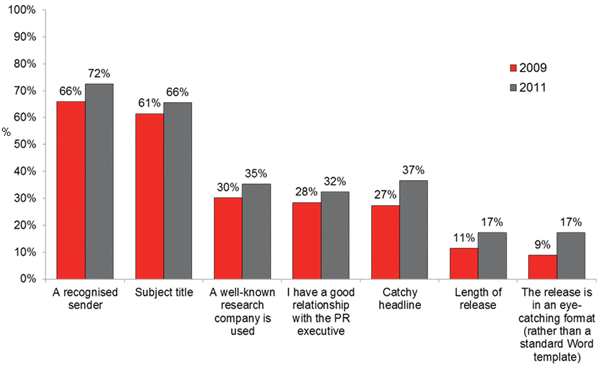According to research carried out by YouGov, journalists are more likely to open and read press releases if they come from a recognised sender. Other key factors that make them decide whether or not to open the release are its subject title, and whether it includes research from a well-known source. It is also worth making sure that the press release is eye-catching, both in its visuals and its use of headlines.
How do journalists choose which emailed press releases to open/read?

Source: YouGov Stone, Base = those with PR responsibility. Base 2009 = 352, October '09 (23/10-29/10): Base 2011 = 337, April '11 (08/04 - 17/04).
When journalists were asked what factors add weight to a PR story, the most important element is that opinions are included from a truly independent and respected spokesperson. A respected celebrity endorsement is not as valuable, but is still worth considerable weight.
Rob Davies, consulting director at communications consultancy oneonone, offers these tips for getting your press releases noticed: “Make the headlines in your emails tell the story straight, without over-egging it. Personalise where you can your covering email and follow up with a phone call (this usually means leaving a voicemail!).”
Davies agrees with the main finding of the YouGov research and says it is key to meet with the journalist so that they know you and your client: “I find once they have met you and your client, they understand that you are credible and will look out for your news releases.”
Daryl Willcox, chairman of media communications specialist DWPub, has further advice on how to get your stories read: “The skill is understanding what, out of everything you have going on, is news, and learning how to communicate it in a timely way that will interest relevant journalists. It is important to understand what angles the readers of the titles you’re pitching to will be interested in.”
He adds: “Write your press release in the style of how it would appear in your chosen publications. The easier you make it for a journalist to understand and use your story, the more likely your efforts will result in press coverage.”
Methodology
The survey was completed by members of the YouGovStone Think Tank of over 4,000 influential people in the UK. The panel members include senior business people, journalists, academics, politicians, directors of charities, health practitioners and other opinion leaders. Around a fifth of panel members completed each survey using YouGov’s bespoke online survey system. The sub-group of those who have PR responsibility was drawn from right across the board of survey respondents. The survey took place in April 2011 and the charts above are based on journalist responses drawn from all the responses.
PR Masterclass: The Intersection of PR and GEO
Join PRmoment for a Masterclass featuring 10 of the industry’s foremost experts. You will walk away with a clear, actionable strategy for adapting your content to an AI-first search environment.
Taking place on Wednesday 25th February in London, both virtual and in person tickets are available.
Early bird ticket sale ends Friday 9 January.
PR MasterclassIf you enjoyed this article, sign up for free to our twice weekly editorial alert.
We have six email alerts in total - covering ESG, internal comms, PR jobs and events. Enter your email address below to find out more:









